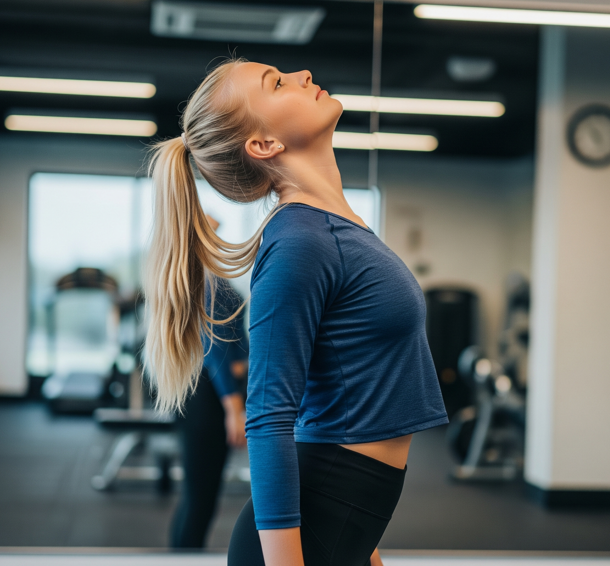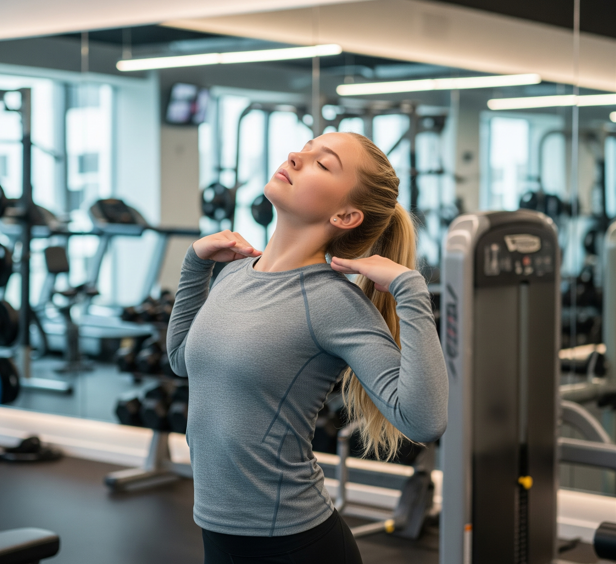HIP FLEXOR
Neck Extension
Improve your Neck Extension Mobility & Strength
Neck extensions and neck rotations are essential for combating stiffness caused by modern lifestyles. These trap and neck stretches target key muscles like the sternocleidomastoid and trapezius, improving flexibility while relieving “tech neck” from constant phone/computer use.
Key Benefits of Neck Extension Exercises & Neck Rotations 🌟
✅ Enhances Flexibility – Improves range of motion in the neck extended position
✅ Reduces Tech Neck Pain – Counters strain from forward head posture
✅ Relieves Tension Headaches – Loosens tight traps and neck stretches
✅ Improves Posture – Strengthens deep neck muscles for better alignment
✅ Boosts Relaxation – Releases stress stored in the neck extension muscles

Neck Extension Stretch
Neck Extension Exercises

Neck Extension
Gently tilting your head backward to stretch the front neck muscles, perfect for counteracting "tech neck" from phone/computer use.

Neck Rotation
Slowly turning your head side-to-side to improve neck mobility and relieve stiffness from poor posture or tension.

Trap and Neck Stretches
These stretches target the upper trapezius and neck muscles, relieving tension from poor posture, stress, or long desk sessions. They improve flexibility and reduce stiffness in the shoulders and neck.
How to Do Neck Extension Stretch: Step by Step Guide: 🏆
1️⃣Neck Extension Exercise
- Sit Tall – Maintain neutral spine, shoulders relaxed
- Perform Neck Tuck – Gently tuck chin (this neck tuck exercise prepares muscles)
- Extend Backward – Slowly tilt head back, eyes toward the ceiling
- Hold 10-15 Sec – Feel stretch in front neck without overextending
2️⃣Neck Rotation Exercise
- Start Neutral – Head centered over shoulders
- Rotate Slowly – Turn head left until chin aligns with shoulder
- Hold 5 Sec – Repeat right side (this neck rotation stretch improves mobility)
Modifications:
- Beginner: Support the head with hand during the neck extensions exercise
- Advanced: Add resistance by pressing the hand against the forehead
3️⃣Trap and Neck Stretches
- Ear-to-Shoulder: Tilt right ear to right shoulder, hold 15s, switch sides.
- Cross-Arm Trap Pull: Pull right elbow across chest with left hand, hold 20s, switch.
- Chin Tuck: Tuck chin to chest, hold 10s for front neck stretch.
- Slow Neck Rotations: Turn head right until chin aligns with shoulder, hold 10s, repeat left.
- Trap Release: Clasp hands behind head, gently pull forward/down, hold 15s.
Quick Reference Table
Muscle Groups Worked | Difficulty Level |
Sternocleidomastoid, Trapezius, Neck Extensors | Easy to Moderate |
Safety Tricks 🛡️
🔹 Move Slowly – Avoid jerky motions in all neck rotation exercises
🔹 Engage Core – Stabilizes spine during neck extension exercise
🔹 Stop if Dizzy – Common when first trying neck extended positions
❌ Avoid These Mistakes
❌ Over-Rotating – In neck rotations, don’t force beyond the comfortable range
❌ Holding Breath – Breathe steadily to maximize flexibility gains
❌ Shoulder Tension – Keep traps relaxed during the neck tuck exercise
Quick Tip:
For an effective neck extension, sit or stand tall, gently tilt your head back while keeping your shoulders relaxed, and hold for 5 seconds. Add a slight chin tuck to deepen the stretch in the front of your neck. Repeat 3–5 times to relieve “tech neck” tension!

